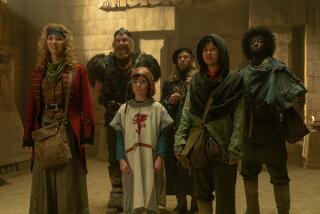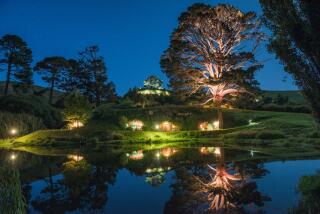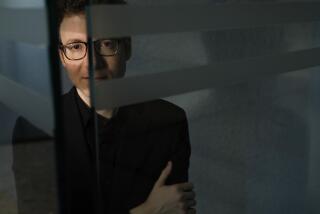Review: ‘The Hobbit: An Unexpected Journey’ lacks a certain ring
- Share via
From an artistic point of view, star Mary Pickford famously said, “It would have been more logical if silent pictures had grown out of the talking instead of the other way around.” Likewise, it would have been better all around if Peter Jackson’s “Lord of the Rings” films had not come before his new, three-part version of “The Hobbit.”
It’s not just that the 1937 J.R.R. Tolkien novel, which he began as a simple bedtime story for his children, was written first and covers events that precede the considerably more complex “Rings” story.
Or that, equally true, the huge success of Jackson’s “Rings” trilogy, both creatively and otherwise (11 Oscars for “The Return of the King” and nearly $3 billion in revenue for all three films), made it inevitable that the new effort would be overshadowed by its more rewarding predecessor.
PHOTOS: 60 images from ‘The Hobbit’
Films as majestic and enthralling as the trilogy are not going to come from a book with “The Hobbit’s” straightforward plot and streak of goofy humor.
But the heart of the problem — at least when it comes to “The Hobbit: An Unexpected Journey,” the first film in the new trilogy — is that all of “Lord of the Rings’ ” success led to a series of choices made for “The Hobbit,” including the decision to push the new 48-frames-per-second technology, known as high frame rate, as the preferred format, that have not worked out for the best.
The result is a film that is solid and acceptable instead of soaring and exceptional, one unnecessarily hampered in its quest to reach the magical heights of the trilogy.
Still, when you are detailing how hobbit Bilbo Baggins changed his life by aiding a band of dispossessed dwarfs in reclaiming their homeland, a fantasy tale so popular it’s sold more than 100 million copies and has been translated into close to 50 languages (a Yiddish version was just added), there is only so far wrong you can go.
Especially with the trio that created “Lord of the Rings” — director Peter Jackson and co-writers Fran Walsh and Philippa Boyens (here joined by Guillermo del Toro) — in charge.
In fact, for most viewers, the best parts of “The Hobbit” will be those that echo the spirit of its “Rings” predecessors. Newcomers Martin Freeman, as Bilbo, and Richard Armitage, as Dwarf Lord Thorin Oakenshield, are excellent, but they don’t involve us the way even glimpses of old friends like Cate Blanchett’s ethereal Galadriel or Hugo Weaving’s Elrond do.
VIDEO: Peter Jackson talks making of ‘The Hobbit’
Best of all, and with the biggest parts, are the indispensable Ian McKellen as the great wizard Gandalf and Andy Serkis as the ever-insidious Gollum.
Similarly, one of the most satisfying parts of “The Hobbit” is its opening prologue, detailing how the rulers of the dwarf kingdom of Erebor got too attached to their gold, attracting the attention of the fierce dragon Smaug (“dragons covet gold with a dark and fierce desire” Bilbo’s convincing voice-over says), who destroys their kingdom and sends them into exile.
Then we break into “The Hobbit” story proper, with a mature Bilbo (Ian Holm again) remembering back to the day his youthful self (Freeman) got an unexpected visit from the magisterial Gandalf, who announces without much preamble that he is “looking for someone to share an adventure.”
Being a hobbit to the bone and in love with creature comforts above all, Bilbo has no use for adventures. “Nasty disturbing uncomfortable things,” he calls them, plus, the ultimate hobbit sin, “they make you late for dinner.”
The adventure in question is helping those dwarfs reclaim their kingdom, a quest that gets a personal touch when all 13 of the rowdy but diminutive folk, led by Thorin Oakenshield, show up at Bilbo’s residence and proceed to eat him out of house and home.
That dwarf bacchanal goes on and on and on. It’s the first evidence of the unwise decision to turn this slender novel into three films that will — if this part’s 2-hour 50-minute running time is any indication — run close to nine hours, something that would never have gotten studio approved absent “Lord of the Rings’ ” success.
VIDEO: ‘The Hobbit: An Unexpected Journey’ trailer
Even though Jackson clearly considers this world a second home he is loathe to leave, there is just not enough story here to prevent things from getting pokey.
Once Bilbo, despite misgivings on both sides, signs on to join the dwarf expedition, much of what happens is a series of wearying battles with unapologetically grotesque creatures like dense trolls and bloodthirsty goblins led by the hideous Great Goblin (Barry Humphries, a long way from Dame Edna.)
This kind of relentless carnage was a big feature of the concluding episode of the trilogy and is a predilection of Jackson and his fellow writers, who have amplified the role of a particularly monstrous orc named Azog the Destroyer to get even more battles into the mix.
Without the balancing emotional material furnished in “Lord of the Rings” by characters like Viggo Mortensen’s Strider, all this violence gets increasingly wearying as all those minutes unfold.
Despite its drawbacks, “The Hobbit,” as noted, does have real virtues, and the best way to appreciate them is to see the movie, whether in 2-D or 3-D, in the traditional 24 frames per second format. Though Jackson and other zealots for high frame rate would have you believe that the new system is more immersive, the truth is just the opposite.
Whatever its virtues may be from a technical point of view, audiences looking for a rich, textured, cinematic experience will be put off and disconcerted by an image that looks more like an advanced version of high definition television than a traditional movie.
If this is, as partisans insist, the future of theatrical projection, one can only think of Marlene Dietrich’s timeless response when Orson Welles asked her to predict his future in “Touch of Evil.”
“Your future,” she said, “is all used up.”
---
MPAA rating: PG-13 for extended sequences of intense fantasy action violence, and frightening images
Running time: 2 hours, 50 minutes
Playing: In general release
MORE FROM HERO COMPLEX
HERO COMPLEX: Pop culture unmasked
PHOTOS: 60 images from ‘The Hobbit’
VIDEO GAMES: The latest news and reviews
More to Read
The biggest entertainment stories
Get our big stories about Hollywood, film, television, music, arts, culture and more right in your inbox as soon as they publish.
You may occasionally receive promotional content from the Los Angeles Times.











